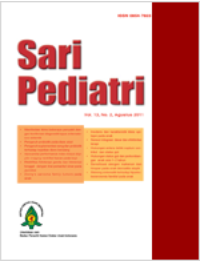Karakteristik Bayi Baru Lahir dengan Resusitasi Berkaitan dengan Kebutuhan Jenis Alat Bantu Napas Saat Lahir
Sari
Latar belakang. Bayi lahir tidak bugar sering mengalami kegagalan adaptasi pernapasan. Kondisi tersebut membutuhkan resusitasi, stabilisasi, yang selanjutnya membutuhkan alat bantu napas bertekanan positif berkelanjutan. Alat bantu napas berfungsi untuk menjaga patensi saluran pernapasan, pertukaran gas di alveoli secara efektif, dan membantu proses humidifikasi.
Tujuan. Penelitian ini diharapkan dapat membantu untuk mempersiapkan berbagai jenis alat bantu napas yang sesuai pada unit-unit perawatan intensif neonatus di rumah sakit.
Metode. Penelitian dilakukan Di RSCM pada periode 2019 sampai dengan 2020, hasil dari penelitian sebanyak 179 (59,8%) bayi lahir membutuhkan resusitasi dan menggunakan alat bantu napas non-invasif, sisanya 121 (40,2%) membutuhkan alat bantu napas invasif.
Hasil. Bayi yang memerlukan alat bantu napas invasif memiliki karakteristik seperti usia gestasi 30,27 (±3,5) minggu, berat badan lahir 1200 (415;4430) gram, jenis kelamin laki-laki 66 bayi dan perempuan 55 bayi, skor APGAR usia menit ke-5 5,5 (±1,7).
Kesimpulan. Semakin kecil usia gestasi, berat lahir, skor APGAR maka semakin tinggi resiko untuk mendapat alat bantu napas invasif. Dengan demikian, bayi dengan karakteristik di atas harus dilahirkan di fasilitas kesehatan yang memiliki alat bantu napas invasif maupun non-invasif.
Kata Kunci
Teks Lengkap:
PDFReferensi
Iskandar ATP. Pengaruh manuver rekrutmen paru terhadap displasia bronkopulmoner dan status hemodinamik bayi prematur yang mengalami sesak napas berat [dissertation]. Universitas Indonesia ; 2020.
Blencowe H, Cousens S, Oestergaard M, Chou D, Moller A, Narwal R, dkk. National, regional, and worldwide estimates of preterm birth rates in the year 2010 with time trends since 1990 for selected countries: a systematic analysis and implications. PubMed. 2012; 9;379(9832):2162-72.
Colin AA, Mcevoy C, Castile RG. Respiratory morbidity and lung function in preterm infants of 32 to 36 weeks gestational age. PubMed 2010;126(1):115–28. doi:10.1542/peds.2009-1381.
Abdul-Mumin A, Owusu SA, Abubakari A. Factors associated with treatment outcome of preterm babies at discharge from the neonatal intensive care unit (NICU) of the Tamale Teaching Hospital, Ghana. Int JPediatr. PubMed.2020 Aug 14;2020:5696427. doi: 10.1155/2020/5696427.
Donda K, Vijayakanthi N, Dapaah?Siakwan F, Bhatt P, Rastogi D, Rastogi S. Trends in epidemiology and outcomes of respiratory distress syndrome in the United States. Pediatr Pulmonol. PubMed. 2019;54(4):405-14. doi:10.1002/ppul.24241.
Dahlan MS. Statistik untuk kedokteran dan Kesehatan: Deskriptif, Bifariat, dan Multivariat.Seri 1 Edisi 6. Jakarta: Salemba Medika; 2015
Najafian B, Aminsaburi A, Fakhraei SH, Afjeh A, Eghbal F, Noroozian R. Predicting factors of INSURE failure in low birth weight neonates with RDS; A logistic regression model. Iranian J Neonatol 2015; Vol 5, Issue 4 :P30-4.
Cunha GS, Mezzacappa-Filho F, Ribeiro JD. Risk factors for bronchopulmonary dysplasia in very low birth weight newborns treated with mechanical ventilation in the first week of life. J Trop Pediatr 2005;Vol 51, Issue 6:P334-40.
Schittny J. Development of the lung. Cell and Tissue Research.PMC. 2017;367(3):427-444.
Saccone G, Berghella V. Antenatal corticosteroids for maturity of term or near term fetuses: systematic review and meta-analysis of randomized controlled trials. BMJ 2016;355:i5044.
Diblasi RM. Neonatal noninvasive ventilation techniques: Do we really need to intubate? Respiratory Care 2011;56:1273-97.
Brew N, Hooper SB, Zahra V, Wallace M, Harding R. Mechanical ventilation injury and repair in extremely and very preterm lungs. Plos One 2013;8. doi:10.1371/journal.pone.0063905.
Bhuta T, Henderson-Smart DJ. Elective high frequency jet ventilation versus conventional ventilation for respiratory distress syndrome in preterm infants. Cochrane Reviews. 1998; Issue 2. Art. No.: CD000328.doi: 10.1002/14651858.CD000328.
Elsmén E, Pupp IH, Hellström-Westas L. Preterm male infants need more initial respiratory and circulatory support than female infants. Acta Paediatrica 2004;93:529-33. doi:10.1080/08035250 410024998.
Elsmén E, Steen M, Hellström-Westas L. Sex and gender differences in newborn infants: why are boys at increased risk? - Journal - Mens Health & Gender 2004;1:303-11.
Dalili H, Sheikh M, Hardani AK, Nili F, Shariat M, Nayeri F. Comparison of the combined versus conventional Apgar Scores in Predicting Adverse Neonatal Outcomes. Plos One 2016;11. doi:10.1371/journal.pone.0149464.
Bruckmann EK, Velaphi S. Intrapartum asphyxia and hypoxic ischaemic encephalopathy in a public hospital: Incidence and predictors of poor outcome. South Afr Med J 2015;105:298.
Jones R, Heep A, Odd D. Biochemical and clinical predictors of hypoxic–ischemic encephalopathy after perinatal asphyxia. The J Matern-Fet Neonat Med 2017;31:791-6. doi:10.1080/14767058.2017.1297790.
Harkness RA, Whitelaw AG, Simmonds RJ. Intrapartum hypoxia: the association between neurological assessment of damage and abnormal excretion of ATP metabolites. J Clin Pathol 1982;35:999-1007.
Prange HD. Laplace’S law and the alveolus: A misconception of anatomy and a misapplication of physics. Advances in Physiol Edu 2003;27:34-40.
Polin RA. Management of neonates with suspected or proven early-onset bacterial sepsis. Pediatrics 2012;129:1006-15. doi:10.1542/peds.2012-0541.
Sharma D, Farahbakhsh N, Shastri S, Sharma P. Biomarkers for diagnosis of neonatal sepsis: a literature review. J Matern-Fet Neonat Med 2017;31:1646-59. doi:10.1080/14767058.2017.1322060.
Ree IMC, Fustolo-Gunnink SF, Bekker V, Fijnvandraat KJ, Steggerda SJ, Lopriore E. Thrombocytopenia in neonatal sepsis: Incidence, severity and risk factors. Plos One 2017;12(10):e0185581.
Cosar H, Yilmaz O, Temur M, Ozun Ozbay P, Bulut Y, Karakulak M. Relationship between early-onset neonatal sepsis and red blood cell distribution width (RDW). J Hematol Thromboembol Dis 2017;05(02). doi: 10.4172/2329-8790.1000266.
Sweet DG, Carnielli V, Greisen G, dkk. European consensus guidelines on the management of respiratory distress syndrome – 2019 Update. Neonatology 2019;115:432-50.doi:10.1159/0004 99361.
Li Z, Xiao Z, Li Z, Zhong Q, Zhang Y, Xu F. 116 cases of neonatal early-onset or late-onset sepsis: A single center retrospective analysis on pathogenic bacteria species distribution and antimicrobial susceptibility. Int J Clin Exp Med 2013 1;6:693-9. PMID: 24040479; PMCID: PMC3762626.
Duke T. Neonatal pneumonia in developing countries. Archives of Disease in Childhood - Fetal and Neonatal Edition 2005;90:211-9.
DOI: http://dx.doi.org/10.14238/sp24.2.2022.83-90
Refbacks
- Saat ini tidak ada refbacks.
##submission.copyrightStatement##
##submission.license.cc.by-nc-sa4.footer##
Email: editorial [at] saripediatri.org


Sari Pediatri diterbitkan oleh Badan Penerbit Ikatan Dokter Anak Indonesia
Ciptaan disebarluaskan di bawah Lisensi Creative Commons Atribusi-NonKomersial-BerbagiSerupa 4.0 Internasional.




